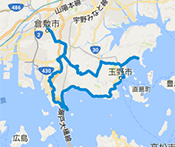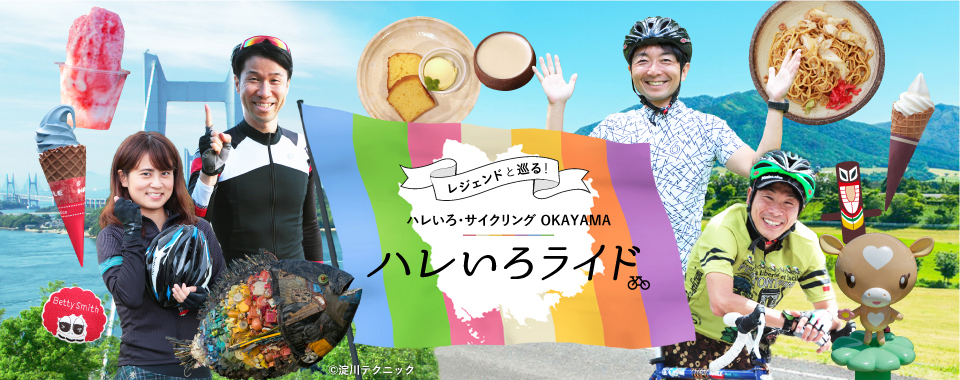BICCHU AROUND HISTORICAL VISITING ROUTE
This route kicks off on reclaimed land by the sea in Kasaoka City where fields bloom with gorgeous seasonal flowers. From there, you glide by the Seto Inland Sea coast to Tamashima, then on to the town of Yakage that enjoyed its heyday as a lodging town in the time of the samurai, visiting many historic sites and scenery along the way.
- Level
- ★★☆Intermediate
- Distance
- 108km
- Highest elevation
- 409m
- Total elevation gain
- 935m
- Average time required
- 3h30m
- Recommended season
- Summer Sunflower season
A comprehensive route that includes sea breezes along the Seto Inland Sea coast and a wealth of historical sites
ROUTE VIEW POINTRoute view point

Roadside Station Kasaoka Bay Farm (Kasaoka City)
This roadside station is next to flower meadows that change with the four seasons, including sunflowers (1 million), cosmos flowers, and canola flowers (10 million). Popular purchases are locally grown fruit and vegetables, and soft-serve ice cream made from local milk and grapes. You can also enjoy a buffet meal.

Kasaoka Municipal Horseshoe Crab Museum (Kasaoka City)
This is the only museum in the world dedicated to the horseshoe crab. It looks out over the Konoshima Channel which is a horseshoe crab breeding ground and a nationally designated natural monument. The building itself is designed in the shape of a horseshoe crab. Visitors to the museum can see live horseshoe crabs up close in the large tanks.

Sami Coast (Kurashiki City)
This public swimming beach has been chosen as one of Japan’s 100 best beaches and visitors can enjoy a cooling dip while taking in the view over the placid waters of the Seto Inland Sea. The Nishihama artificial beach created in 1989 is another must-visit spot.

Entsu-ji Temple (Kurashiki City)
This ancient temple of the Soto School of Zen Buddhism is known as the place where the Edo-period monk Ryokan undertook his training. Points of particular interest are the rock garden and the impressive and imposing thatched buildings in the temple grounds. In the temple grounds and its neighbor Entsu-ji Park, visitors can appreciate a variety of flowers all year round.

Makibi Park (Kurashiki City)
Makibi Park was created to honor the memory of the great scholar and nobleman Kibi-no-Makibi for future generations. This Chinese style garden is one of few such gardens in the whole of Japan. Within the park are the Makibi Museum, the Takenoko Tea Room, and the Bamboo Workshop.

Onigadake (Ibara City)
Onigadake is situated along a 4 km stretch of the Miyama River, a tributary of the Oda River, where the riverbanks are formed from distinctive rock formations known as platy joints. Also, it is awesome to see that the river has carved a varied and contrasting waterscape of pools, shallows, and waterfalls. The best time to visit is in the autumn when the golden leaves are shining.

Hoshi-no-Sato Open-air Market (Ibara City)
This market sells a variety of produce, including fresh local fruit and vegetables from Bisei Town in Ibara City as well as cut flowers, locally sourced Bisei milk, other milk products, and grilled pork. Almost all items are sold at very reasonable prices and the market is extremely popular with both locals and visitors.

Chusei-Yumegahara (Ibara City)
Chusei-Yumegahara is a park exhibiting village life in the Kibi highlands from the Kamakura to Muromachi periods (12th-16th centuries) based on accurate research. The facility also offers various hands-on experiences, including making a bamboo dragonfly toy, indigo dyeing, making country-style soup, rice pounding, and making items from lavender blossoms (reservations required).

Yakage Honjin Former Ishii Residence (Yakage Town)
The honjin functioned as a lodging house for feudal lords, nobles, and other members of samurai clans who had to travel regularly to Edo (modern-day Tokyo). This smart and stylish old residence shows just how prosperous Yakage was back in its heyday. The Yakage Shukuba Matsuri (festival) is held on the second Sunday of November each year and recreates the procession of a daimyo (feudal lord).

Kasaoka Ramen Noodles (Kasaoka City)
As home to many chicken farms, over the years, Kasaoka has built up a wealth of knowledge about the best ways to use all parts of chickens young and old. One of the most famous dishes is Kasaoka ramen noodles, made using a flavorful stock made from chicken bones and slices of roast chicken. Although not a heavy soup, you will find its rich umami flavors irresistible!
ACCESSAccess to start and finish point(s)
START & GOAL
Roadside Station Kasaoka Bay Farm
245-5 Kabuto Minamimachi, Kasaoka City 714-0046
- ●Via car:
- Approx. 25 minutes from the Kasaoka IC on the Sanyo Expressway
- ●Via train:
- From JR Okayama Station
Aprox. 40 minutes to JR Kasaoka Station, get off at JR Kasaoka Station, then approx. 15 minutes by taxi
PARKING SPACEParking lots around the start and along the route
Parking
-
- Roadside Station Kasaoka Bay Farm▲Near the start and finish point(s)
- 245-5 Kabuto Minamimachi, Kasaoka City 714-0046
- Parking lot: Approx. 31 cars, 11 large vehicles, temporary parking lot available, and EV charging station (1 rapid) (free)
-
- Asakuchi Mitsuyama Sports Park
- 16089-24 Yorishima-cho, Asakuchi City 714-0101
- Parking lot: Approx. 150 cars, 5 buses (free)
-
- Bisei Farmer's Market
- 55-1 Nishimizusuna, Bisei-cho, Ibara City 714-1413
- Parking lot: Approx. 128 cars, 3 large vehicles, and EV charging stand (1 medium speed) (free)
-
- Sami Beach
- Tamashima Kurosaki, Kurashiki City 713-8126
- Parking lot: Approx. 160 cars (free), temporary parking lot for approx. 800 cars (paid, 500 yen)
*Temporary parking lot is only available during the ocean swimming season
HOTELRecommended hotels for cyclists
-
Yakage-ya, Inn and Suites

- Address
- 3050-1 Yakage, Yakage-cho, Oda-gun 714-1201
- TEL
- 0866-82-0111
- HP
- Hotel Website
-
People’s Lodges Ryokan so

- Address
- 478 Tamashima Kashiwajima, Kurashiki City 713-8123
- TEL
- 086-522-5291
- HP
- Hotel Website
- KURASHIKI TAMANO
SEASIDE ROUTE - Level of difficulty / ★★☆ Intermediate

- Distance
- 90km
- Highest elevation
- 219m
- BICCHU AROUND
HISTORICAL VISITING ROUTE - Level of difficulty / ★★☆ Intermediate
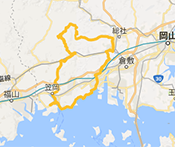
- Distance
- 108km
- Highest elevation
- 409m
- OKUKIBI
YAMABIKO ROUTE - Level of difficulty / ★★★ Advanced
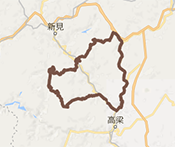
- Distance
- 83km
- Highest elevation
- 451m
- MANIWA SHINJO
YAMANAMI ROUTE - Level of difficulty / ★★☆ Intermediate
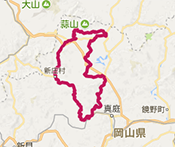
- Distance
- 100km
- Highest elevation
- 539m
- KATATETSU
ROMAN KAIDOU ROUTE - Level of difficulty / ★★☆ Intermediate
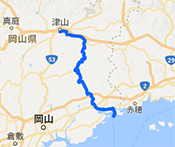
- Distance
- 76km
- Highest elevation
- 125m
- OKAYAMA KAGAMINO
THROUGH ROUTE - Level of difficulty / ★★★ Advanced
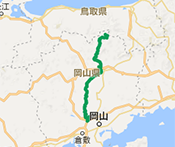
- Distance
- 114km
- Highest elevation
- 791m
- KIBIJI
CYCLING ROUTE - Level of difficulty / ★☆☆ Beginner

- Distance
- 25km
- Highest elevation
- 26m
- HIRUZEN-KOGEN
HEIGHTS CYCLING ROUTE - Level of difficulty / ★☆☆ Beginner
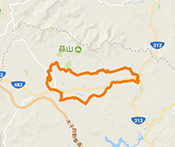
- Distance
- 29km
- Highest elevation
- 135m

KURASHIKI TAMANO
SEASIDE ROUTE
- Level / ★★☆ Intermediate
-
- Distance
- 90km
- Highest elevation
- 219m
BICCHU AROUND
HISTORICAL VISITING ROUTE
- Level / ★★☆ Intermediate
-
- Distance
- 108km
- Highest elevation
- 409m
OKUKIBI
YAMABIKO ROUTE
- Level / ★★★ Advanced
-
- Distance
- 83km
- Highest elevation
- 451m
MANIWA SHINJO
YAMANAMI ROUTE
- Level / ★★☆ Intermediate
-
- Distance
- 100km
- Highest elevation
- 539m
KATATETSU
ROMAN KAIDOU ROUTE
- Level / ★★☆ Intermediate
-
- Distance
- 76km
- Highest elevation
- 125m
OKAYAMA KAGAMINO
THROUGH ROUTE
- Level / ★★★ Advanced
-
- Distance
- 114km
- Highest elevation
- 791m
KIBIJI
CYCLING ROUTE
- Level / ★☆☆ Beginner
-
- Distance
- 25km
- Highest elevation
- 26m
HIRUZEN-KOGEN
HEIGHTS CYCLING ROUTE
- Level / ★☆☆ Beginner
-
- Distance
- 29km
- Highest elevation
- 135m
- ●Tourist-related inquiriesTourism Division, Industry and Labor Department, Okayama Prefecture TEL 086-226-7382
- ●Inquiries about the recommended cycling routesRoad Maintenance Division, Civil Engineering Department, Okayama Prefecture TEL 086-226-7472
©Hareiro Cycling Okayama, All Rights Reserved



